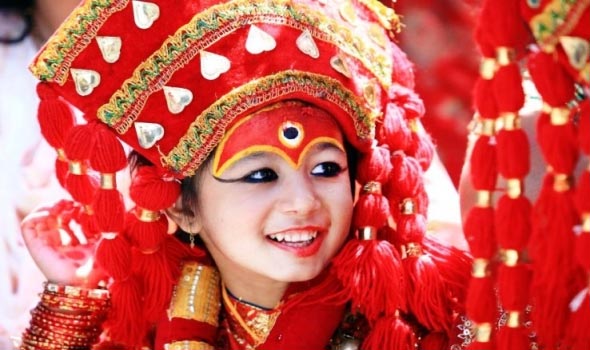
Indra Jatra Festival and Its Mythology:
According to legend, on the day of Ganesh Chaturthi, the heavenly fairy 'Basundhara' fasts. She needed a kind of sour fruit and a flower of Parijat to worship.
On the day of Bhadra Shukla Dvadashi, the king of heaven, Indra, came from heaven to pick the flowers of Parijat in the mortal world (earth). He did not bring the Airawat elephant as his excuse.
While Indra is picking the flowers and fruits of Parijat, the people of the earth find him. Indra is found in a toll booth with stolen fruits and kept in a visible place. Indra does not leave him even if he is God. Because he is bound to say, 'Whoever is a thief is a thief.'
Even though he is the king of heaven, he is treated like this because he steals from the people of the earth without asking.
For a long time, Indra did not return to heaven. Then Basundhara finds out that Indra is a prisoner. Then she comes to earth in the guise of 'Dakini'. She brings cold and fog with her so that no one can see her. She brings the Airavat elephant with her and steals it and takes it to Indra.
In the Newar Community, the Linga is placed here and there as a symbol of Indra. The Linga is wrapped 9 times and flowers are also kept. The Linga is flashed to be visible. Indra Jatra is celebrated to commemorate this day after Indra fled.
According to cultural expert Purushottam Lochan Shrestha, even though Indra is God, he is not considered as a true character. Even though Indra Jatra is celebrated culturally, it has a philosophical meaning.
According to the legend, Indra was not respected in the heavenly world.
According to cultural expert Shrestha, Indra Jatra is a struggle between 'monarchy and republic'.
Indra was the symbol of autocratic monarchy and Krishna was the symbol of the republic. Indra Jatra is a reminder of their victory and defeat. After Indra became autocratic, the citizens started worshiping Krishna. Krishna always got along with the people. Krishna made the people worship Govardhana. Krishna became a devotee and stopped praising Indra.
Indra became angry with the people. Indra is not only the god of war but also the god of rain and electricity. Then Indra rained hail and lightning from the sky. "It is due to the change of environment, otherwise it would have rained with wind and lightning in Bhadau some time ago, sometimes hail would have come," says Shrestha.
It is mentioned in the legend that this procession is celebrated in memory of Indra, a prisoner who came to the earth to steal flowers.
The practice of celebrating Indrajatra has been going on for 2000 years. Vedic literature is proof of this. It has been a custom to praise Lord Indra since about 4000 years ago. One of the four Vedas, the Rig Veda, praises Lord Indra everywhere.
According to culturologist Purushottam Lochan Shrestha, the Rig Veda dates back to 4,000 years ago. This is the time of development of Mawan civilization and revolution in agriculture.
It is mentioned in the Atharva appendix of 800 BC that the practice of worshiping by making a rainbow flag has already started. The Comprehensive Code, which is written in the fifth Ishwati Samvat, also mentions the method of raising the Indra flag.
The practice of raising the rainbow flag and performing the yajna is proved to be going on in the Vedic period.
The facts show that the arrival of Licchavi in Nepal took place before Isha. He is a republican in India but in Nepal, he seems to have ruled the monarchy by defeating Kirant. However, after the rule of the Licchavi, Indrajatra has been celebrated with more pomp in Nepal, says cultural expert Shrestha.
Indragosthi and Dhwaj Gosthi are mentioned in the records written by Lichhivi king Shivadev Anshu Burma. Accordingly, the practice of waving the flag by raising the Linga was developed at that time.
Indra Jatra expanded in the Middle Ages. The Middle Ages are considered to be the age of Tantra Vidya, during which time it became customary to celebrate the one-day Indrajatra from Bhadra Shukla Dwadashi to Ashwin Krishna IV. This journey, like the Biscuit procession, lasted for 8 nights and 9 days. In Newari, it is called 'Chanhu Chachaya Jatra'.
Celebrating this procession means 'victory celebration'. Somewhere it is celebrated as a post-war victory celebration, he says. Cultural expert Shrestha says, ‘War is not just a war between people, it can also be a celebration of victory against disease and epidemics.
The Kumari Jatra, which became the center of attraction in Indrajatra, was added during the reign of King Jayaprakash Malla.
Indra Jatra is more prevalent in Nepal where the Newar community resides. It is celebrated especially in Kathmandu, Patan, Bhaktapur, Dhulikhel, Dolakha, and other places.
But according to cultural expert Shrestha, the procession introduced the place. Until five decades ago, when people introduced themselves, it was customary to ask 'which journey to follow' rather than 'name'. If someone said that he considered himself Indrajatra, he was automatically understood to be from Kathmandu.




